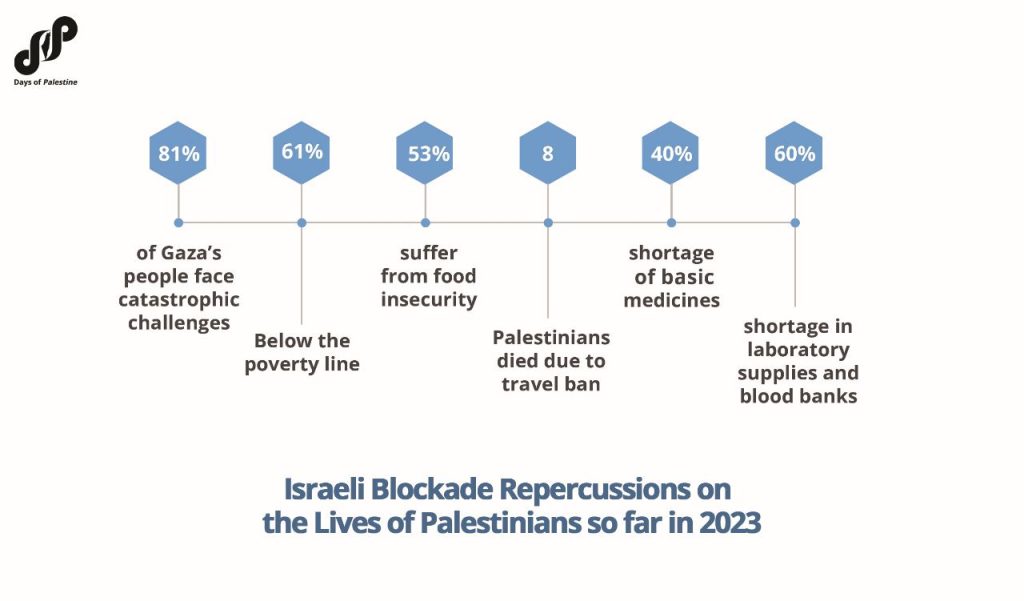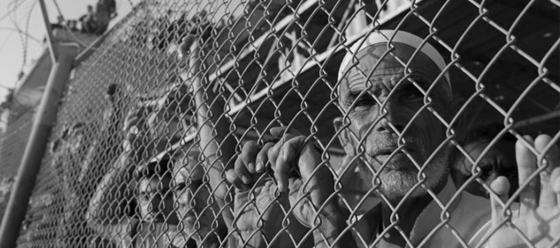Marking the 16th anniversary since it was forced on the Gaza Strip since June 2006, Israel has been enforcing an open-air prison in the Gaza Strip, the West Bank, and Jerusalem, which is seen as a gross breach of international law, exacerbating the suffering of Palestinians by all means.
Gaza Siege Dangerously Affects the Humanitarian Situation in the Gaza Strip
The humanitarian situation in the Gaza Strip is still deteriorating, that by June 2023, Gaza blockade has caused the impoverishment of more than 61% of the population of the Strip, which is about 2.380 thousand people.
Obvious Deterioration in the Medical Sector in the Gaza Strip
There is a significant deterioration in the health sector as a result of the Israeli blockade according to the Palestinian Ministry of Health in the Gaza Strip.
In terms of the pharmaceutical reality, more than 20% of essential drug lists have become zero stock by June 2023, and more than 40% are not even enough for more than 3 months.
In terms of laboratory materials, there is a shortage of more than 30 basic items, while in terms of medical consumables and surgical instruments, the health sector suffers from a severe shortage in stocks, in addition to the occupation’s obstruction of the entry of most necessary medical devices for medical radiotherapy for cancer patients, which doubles their suffering
Moreover, there is a great Loss in the stock of fuel needed to operate generators, which endangers the lives of Gazan patients inside hospitals in light of the hours of power outages.
Israeli Blockade Affects the Economic Situation in the Gaza Strip
By mid-June 2023, Israeli blockade has prevented about 47% of Palestinian participants in the labor force from working as approximately 53% of the population suffers from food insecurity.
The continuation of Israeli restrictions on the movement of people and goods to and from the Gaza Strip through the Erez and Kerem Shalom crossings, as the exit of individuals is mainly limited to humanitarian cases that obtain transit permits after a lengthy security check.
Meanwhile, the Israeli side continues to ban the entry of large numbers of people, important materials, and equipment for the health, commercial and production sectors under security pretexts.
The Majority of Palestinians in the Gaza Strip and the West Bank are Under Poverty Line
The dangerous rise in poverty rates reached 80%, severe poverty reached 36%, and the unemployment rate reached 85%. UNRWA announced that 80% of the population in the Gaza Strip is totally dependent on humanitarian aid.
31 percent of Palestinians in the West Bank and 81 percent in Gaza face challenges in meeting basic essential needs, especially in accessing food, health and public utilities.
So far in 2023, reports have shown that 8% of families in the West Bank and 73% of families in Gaza received humanitarian assistance.
Gaza Siege Also Affects Agricultural & fishing sector
There are more than 3,500 Palestinian fishermen who depend on fishing to put food on the table, in addition to a number of assistants, who support a total of more than 45,000 people who have no source of another income, which the Israeli occupation has intensively and deliberately targeted.
According to the signed agreements, fishermen should be allowed to sail a distance of 20 miles. The occupation forces reduced this distance to 6 miles, and after the 2008 aggression, shooting was a warning given to every fisherman who approaches a distance of 3 miles, and sometimes from a distance of 2 miles.
In recent years, the catch rate has recorded only 70 tons per month, and this greatly affects the fisherman’s income.
Because of the siege and wars that the Gaza Strip went through, about (85%) of the agricultural sector was destroyed, and throughout the years of the blockade, agricultural lands and crops were damaged due to the lack of water and the ban on entry of fertilizers and grains.
Citrus trees used to cover more than 75 thousand dunums, but today they have decreased to 17 thousand dunums, due to the blockade, the salinity of water, and the cessation of export operations abroad.
Repercussions of the Electricity Crisis
The electricity crisis in the Gaza Strip dates back to the start of the blockade in 2006, when Israeli forces bombed the six main transformers at the only power plant in Gaza.
Despite the partial repair of the station, there is a shortage of the fuel needed to operate it, which causes a huge deficit in the supply of electric power, as the hours of power outages reach 12 hours a day.
Under international law, the Gaza Strip remains under Israeli occupation despite the unilateral withdrawal from the Strip in 2005, as Israel retained full control over the Strip’s land, sea, and air access.
Likewise, it controls Gaza’s population registry, communications networks, and many other aspects of daily life and infrastructure. Instead of doing its duty to protect the Palestinian civilian population, Israel has imposed an unprecedented form of collective punishment on the population of the Gaza Strip, in a flagrant violation of international humanitarian law.

Shortlink for this post: https://daysofpalestine.ps/?p=43448







